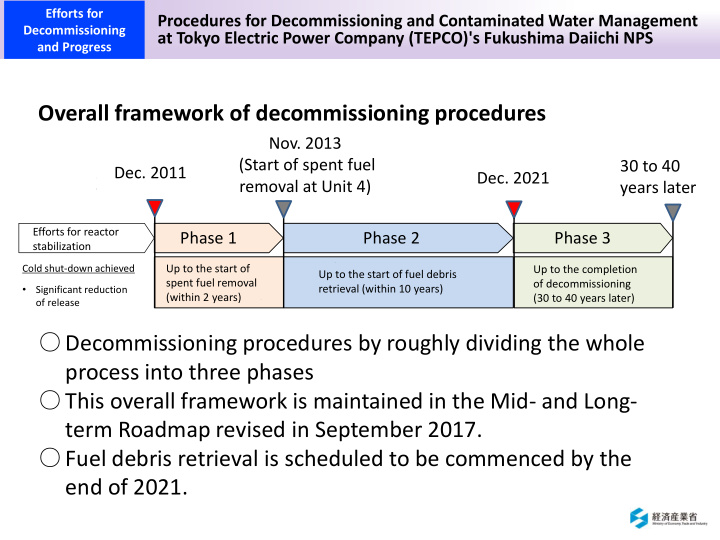



Efforts for Procedures for Decommissioning and Contaminated Water Management Decommissioning at Tokyo Electric Power Company (TEPCO)'s Fukushima Daiichi NPS and Progress Overall framework of decommissioning procedures Nov. 2013 2013年11⽉ (Start of spent fuel 30〜40年後 30 to 40 Dec. 2011 2021年12⽉ 2011年12⽉ Dec. 2021 (4号機燃料取り出し開始) removal at Unit 4) years later 安定化に向けた取組 第1期 第2期 第3期 Efforts for reactor Phase 1 Phase 2 Phase 3 stabilization 冷温停⽌状態達成 燃料デブリ取り出しが 廃⽌措置終了までの期間 使⽤済燃料取り出し開始 Cold shut‐down achieved Up to the start of Up to the completion Up to the start of fuel debris spent fuel removal of decommissioning ・放出の⼤幅抑制 までの期間(2年以内) 開始されるまでの期間(10年以内) (30〜40年後) • retrieval (within 10 years) Significant reduction (within 2 years) (30 to 40 years later) of release ○ Decommissioning procedures by roughly dividing the whole process into three phases ○ This overall framework is maintained in the Mid‐ and Long‐ term Roadmap revised in September 2017. ○ Fuel debris retrieval is scheduled to be commenced by the end of 2021.
Reduction of Radiation Doses in Surrounding Efforts for Decommissioning Environment and Progress Land Sea area area Changes in concentrations of radioactive Testing of antiscattering agents for their dust holding capacity materials in the surrounding sea area Scattering of agents are not radioactive materials Antiscattering agents are used is suppressed by Antiscattering Cs‐137 spraying antiscattering agents under the condition of used WHO guideline level for instantaneous wind drinking water quality (10 Bq/L) velocity up to 50m/s. Cover the premises of the Fukushima Daiichi NPS with mortar to suppress scattering of radioactive materials 2011 2012 2013 2014 2015 2016 Mar. Mar. Jun. Sep. Dec. Mar. Mar. Mar. Jun. Sep. Dec. Jun. Sep. Jun. Sep. Dec. Mar. Jun. Jun. Sep. Dec. Sep. Dec. Evaluation of annual exposure doses at the site boundary due to Cs from reactor buildings of Unit 1 to Unit 4 Exposure dose (mSv/year) Site boundary Units Radiation monitoring posts; Dust monitors
Measures against Recriticality and Future Efforts for Decommissioning Earthquakes and Tsunamis and Progress ■ Amount of noble gases generated Radioactivity Radioactivity concentrations (1) concentrations (2) Reactor building Monitoring room As of 00:00 on December 8, 2017 Measurement point (1) Radioactivity concentrations of Xe‐135 in gas sucked in from the reactor building after filtering are measured at two points Measurement point (2) Flow of gases in the monitoring room (1) and (2) in this figure. Filter Outdoors ■ Measures against earthquakes and tsunamis Through computer analyses and other means, it has been confirmed that reactor buildings and other major facilities are sound enough to withstand any earthquakes or tsunamis equivalent to or even bigger than the Great East Japan Earthquake. Backup power sources Securing of power sources in an emergency such as emergency In preparation for power loss, ordinary power sources have been multiplexed and emergency power supply vehicles and gas turbine vehicles are put in place. These vehicles are to be used power supply vehicles to supply power to water injection facilities in an emergency. and water injection means such as fire engines are placed at a higher area where tsunamis are unlikely to reach. Temporary seawall Water injection drill Fire engines Emergency power supply vehicle (Source: Website of Tokyo Electric Power Company)
Improvement of Working Environment at the Efforts for Decommissioning Fukushima Daiichi NPS and Progress 福島第⼀原発構内図 Premises of the Fukushima Daiichi NPS 500m 線量が⾼く防護服等 Area where doses are high and workers need to wear を必要とするエリア protective clothes 線量が低く⼀般作業服 Area where doses are low and workers can work in で作業可能なエリア ordinary work clothes Area where workers can work Areas where workers need to wear protective clothes in ordinary work clothes Provided by Japan Space Imaging Corporation and (c) Digital Globe Prepared by the Ministry of Economy, Trade and Industry based on the materials of Tokyo Electric Power Company
Efforts for Measures against Contaminated Water Decommissioning and Progress Preventive and multi‐layered measures are being taken against contaminated water based on policies of (i) removing contaminant sources, (ii) isolating groundwater from contaminant sources, and (iii) preventing leakage of contaminated water. Removing contaminant Preventing leakage of Isolating groundwater contaminated water sources from contaminant sources Facing Temporary water Cleanup system for subdrain and storage tanks groundwater drain Groundwater bypass Cleanup of contaminated water Subdrain Increase of tanks Land‐side impermeable wall Storage tank area Water collection tanks Reactor buildings Turbine buildings Seawater piping trench Groundwater drain Sea‐side impermeable wall Prepared by the Ministry of Economy, Trade and Industry based on the materials of Tokyo Electric Power Company
Efforts for Decommissioning Measures Decommissioning and Progress Current status of Unit 1 to Unit 4 at the Fukushima Daiichi NPS Unit 1 to Unit 3 are being kept stable and preparation work for fuel removal from spent fuel pools is underway (debris retrieval, decontamination, shielding and installation of fuel removal equipment, etc.) Policies for the retrieval of fuel debris (fuel that melted at the time of the accident and then solidified) were decided. Concrete retrieval methods will be discussed from now on. Unit 2 Unit 3 Unit 4 Unit 1 Cover for fuel removal work Hydrogen explosion Dome Spent fuel pool Fuel handling crane Removed fuel assemblies: Fuel handling 1533/1533 machine girder Shield (Fuel removal completed on Dec. 22, 2014) 392 fuel Coolant assemblies 615 fuel Coolant injection assemblies 566 fuel injection assemblies Coolant injection Fuel debris Fuel melt Fuel melt At the time of At the time of At present At present At the time of At present At the time of the accident the accident At present the accident the accident Completed dismantlement of Started construction of a working platform Started installation of the cover, etc. building covers [Nov. 2016] to reach the top floor of the building [Sep. 2016] for fuel removal work [Jan. 2017] Fuel removal completed Commencement of fuel removal Commencement of fuel removal: FY2023 (Around the mid‐FY2018) There is no fuel debris. Commencement of fuel debris retrieval at any of Units 1 to 4: Within 2021
Recommend
More recommend